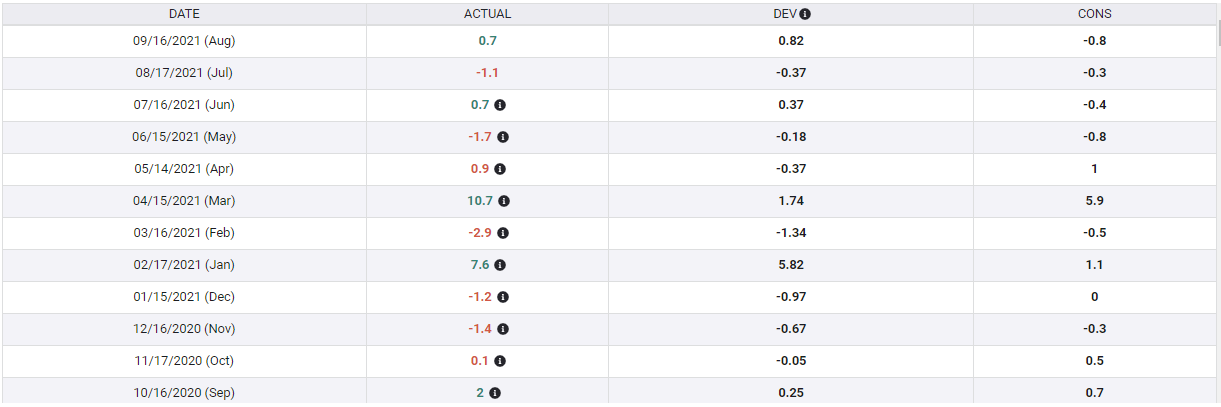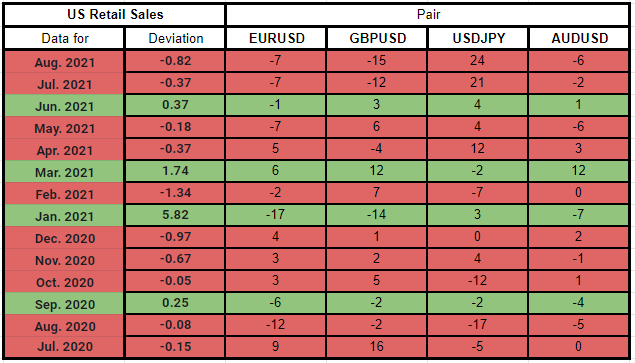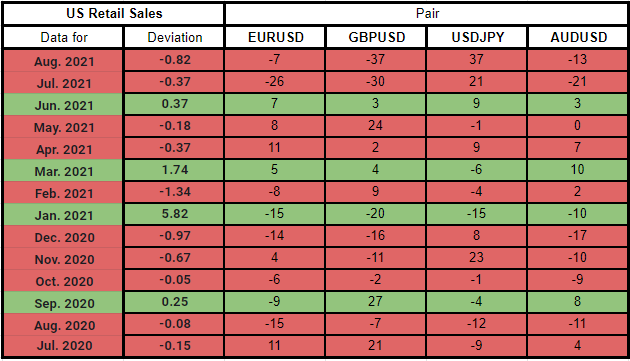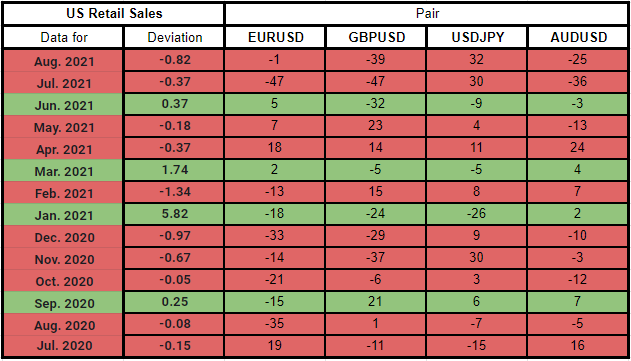- Retail Sales in the US is expected to decline modestly following August's rebound.
- Correlation analysis does not reveal a strong relationship between initial market reaction and deviation.
- USD/JPY has a strong negative correlation with sales data surprises four hours after the release.
The US Census Bureau will release the September Retail Sales report on Friday, October 15. Following an increase of 0.7% in August, Retail Sales are expected to decline by 0.2% on a monthly basis.
The general market view is that a positive surprise in the Retail Sales reading is likely to provide a boost to the greenback and vice versa. In order to understand how impactful this data is on the USD’s performance against its rivals, we analyzed the market reaction of four major pairs, EUR/USD, GBP/USD, USD/JPY and AUD/USD, to the previous 14 Retail Sales prints.
Methodology
The FXStreet Economic Calendar assigns a deviation point to each macroeconomic data release to show how big the divergence was between the actual print and the market consensus. Although Retail Sales were unchanged in April, the deviation was -0.37 because analysts were expecting a 1% increase.
On the flip side, the 7.6% increase recorded in January against analysts’ estimate of 1.1% was a relatively big positive surprise with the deviation posting 5.82 for that particular release.
“Deviation: It measures the surprise caused when the Actual data differs from the Consensus. It can oscillate in an open scale, usually between -7 and +7.”
Next, we plotted the reaction, in terms of pips, of the major pairs mentioned above 15 minutes, one hour and four hours after the release to see if the general market view held.
Finally, we calculated the correlation coefficient (r) to figure out which major pair had the strongest correlation at which time frame. When r approaches -1, it suggests there is a significant inverse correlation, while a significant positive correlation is identified when r moves toward 1.
Results
There were 10 negative surprises and four positive surprises in the previous 14 releases. On average, the deviation was -0.5 on disappointing prints and 2 on upbeat figures. 15 minutes after a negative surprise, EUR/USD and AUD/USD on average lost 1.1 and 1.4 pips, respectively, while the GBP/USD and USD/JPY gained 0.4 and 2.4 pips, respectively. On the other hand, EUR/USD and GBP/USD fell 4.5 and 0.25 pips respectively on average following positive surprises while AUD/USD and USD/JPY gained 0.5 and 0.75 pips, respectively. This finding suggests that the initial market reaction to Retail Sales data is largely muted.
15-min deviation chart
60-min deviation chart
240-min deviation chart
EUR/USD
EUR/USD has a correlation coefficient of -0.46, -0.13 and 0 15 minutes, 60 minutes and 240 minutes after the release, respectively. These numbers suggest that the inverse correlation between the Retail Sales deviation and EUR/USD action is virtually non-existent one hour and four hours after the release. Although the initial reaction is somewhat correlated, the average pip-change is too small to consider it as a trading opportunity.
GBP/USD
GBP/USD has a correlation coefficient of -0.27, -0.11 and -0.08 15 minutes, 60 minutes and 240 minutes after the release, respectively. Similar to EUR/USD, the inverse correlation of the GBP/USD pip-change with the Retail Sales deviation weakens gradually and fades away four hours after the release.
USD/JPY
USD/JPY has a correlation coefficient of -0.05, -0.48 and -0.65 15 minutes, 60 minutes and 240 minutes after the release, respectively. The pair’s initial reaction to Retail Sales data is largely unpredictable. However, the correlation turns inverse one hour after the release and becomes significant by the fourth hour. This finding suggests that if Retail Sales print is better than expected, USD/JPY falls and vice versa.
AUD/USD
AUD/USD has a correlation coefficient of -0.11, 0.05 and 0.16 15 minutes, 60 minutes and 240 minutes after the release, respectively, making it the least correlated pair, out of the four tested, with US Retail Sales surprises.
Summary
When there is a negative or a positive surprise in US Retail Sales data, the initial market reaction is insignificant. There is no clear relationship between the movements of EUR/USD, GBP/USD and AUD/USD pairs and the deviation one hour and four hours after the release. This could be due to the fact that Retail Sales is impacted by temporary factors, such as weather conditions and holiday seasons, making it an unreliable leading indicator.
The most interesting finding is the strong inverse correlation with USD/JPY and Retail Sales deviation four hours after the release. Nevertheless, the average pip-change on that time frame is 10.5 and 1.75 pips on a negative and positive deviation, respectively, not providing enough room for a trading opportunity.
Information on these pages contains forward-looking statements that involve risks and uncertainties. Markets and instruments profiled on this page are for informational purposes only and should not in any way come across as a recommendation to buy or sell in these assets. You should do your own thorough research before making any investment decisions. FXStreet does not in any way guarantee that this information is free from mistakes, errors, or material misstatements. It also does not guarantee that this information is of a timely nature. Investing in Open Markets involves a great deal of risk, including the loss of all or a portion of your investment, as well as emotional distress. All risks, losses and costs associated with investing, including total loss of principal, are your responsibility. The views and opinions expressed in this article are those of the authors and do not necessarily reflect the official policy or position of FXStreet nor its advertisers. The author will not be held responsible for information that is found at the end of links posted on this page.
If not otherwise explicitly mentioned in the body of the article, at the time of writing, the author has no position in any stock mentioned in this article and no business relationship with any company mentioned. The author has not received compensation for writing this article, other than from FXStreet.
FXStreet and the author do not provide personalized recommendations. The author makes no representations as to the accuracy, completeness, or suitability of this information. FXStreet and the author will not be liable for any errors, omissions or any losses, injuries or damages arising from this information and its display or use. Errors and omissions excepted.
The author and FXStreet are not registered investment advisors and nothing in this article is intended to be investment advice.
Recommended Content
Editors’ Picks
EUR/USD eases toward 1.0700 as USD finds feet ahead of ADP, Fed Minutes

EUR/USD is retreating toward 1.0700 in the early European session on Wednesday. The pair struggles, as the US Dollar finds its feet in the aftermath of the dovish Fed Chair Powell's comments. Cooling EU inflation keeps the Euro undermined. Eyes turn to US ADP data, Fed Minutes.
GBP/USD flatlines below 1.2700, looks to US data/Fed minutes

GBP/USD is lacking a firm directional bias below 1.2700 on Wednesday, reversing early gains. Traders appear reluctant and prefer to wait on the sidelines ahead of the FOMC minutes while the UK elections on Thursday also keep them on the edge. US ADP data eyed as well.
Gold eyes a range breakout, as Fed Minutes looms

Gold price is trading around a flatline near $2,330 early Wednesday, as traders consider the recent US jobs data and Federal Reserve Chairman Jerome Powell’s speech, bracing for yet another busy US calendar.
Bitcoin struggles around $64,000 level

Bitcoin faces resistance near the $64,000 daily level, leading to a 1.05% decline in trading on Wednesday. Ethereum and Ripple similarly encounter resistance, resulting in 1% and 0.5% declines, respectively.
ADP Employment Change Preview: US private sector expected to add 160K new jobs in June

The United States ADP Research Institute will release its monthly report on private sector job creation for June. The announcement is expected to show that the country’s private sector added 160K new positions in June after adding 152K in May.











